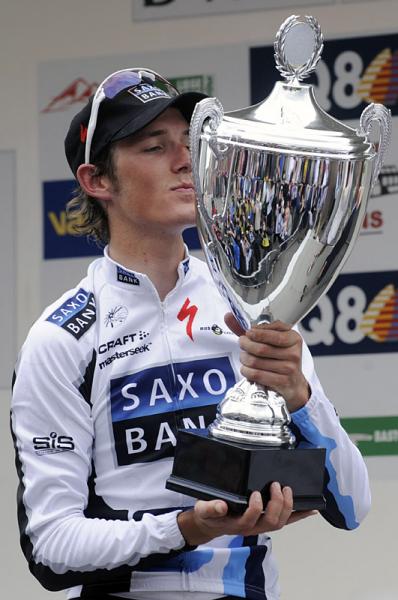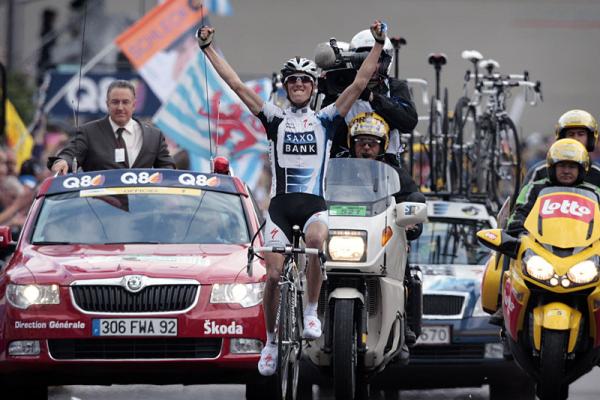Last call for spring classics at Liège
Defending champ Andy Schleck faces a field full of favourites


The curtain falls on the spring Classics on Sunday with the 96th edition of Liège-Bastogne-Liège, the so-called 'Doyenne', or the oldest, grandest and perhaps most sought after 'monument' Classic of them all.
It has been a spring of spectacular racing, with some prestigious winners, dominant performances and emotional victories. Sunday's race offers a great final act before the attention turns to the Giro d'Italia, the Tour of California and then the Tour de France.
World champion Cadel Evans (BMC), 2009 Liège-Bastogne-Liège winner Andy Schleck (Saxo Bank), local hero Philippe Gilbert (Omega Pharma-Lotto), Damiano Cunego (Lampre-Farnese Vini) Alejandro Valverde (Caisse d'Epargne) and Alberto Contador (Astana) will all battle it out on the steep hills of the southern Wallonne region. They are all on form, eager to win and able to win, promising one of the most aggressive and wide-open races for years.
Eight cotes in the last 100km
Belgian amateur rider Léon Houa won the first three editions of Liège-Bastogne-Liège between 1892 and 1894, when race officials used to catch trains to arrive in time to see the riders reach the mid-race check points.
This year's race route starts in the Place Saint-Lambert in the centre of Liège and ends 258km later in the suburb of Ans. In between the race heads south to Liège along the valleys and returns north via a far hillier and twisting route.
Eight of the ten categorised climbs or 'cotes' are in the final 100km, inspiring a constant fight for position and painful test of riders' strength and fitness.
The Côte de Wanne (2.7km at 7%) is the first climb of the final eight, after 159km, and is quickly followed by the Côte de Stockeu (1.1km at 10.5%). Major road works have forced the organiser ASO to avoid the Haute-Levée and Vecquée climbs but they have scouted the area carefully and found the equally tough Col du Rosier (6.4 km at 4%) after 186km and the Col du Maquisard (2.8 km at 4.5%) after 198km.
The Côte de la Redoute (2.1km at 8.4%) is next after 223km. As it rises across the side of the hill, with the autoroute creating an unusual background, the steepest, crowd-packed section of the climb is often the launch-pad for the first real selection amongst the favourites, with the false flat over the top making any gaps widen to breaking point.
The Côte de la Roche aux Faucons (1.5km at 9.9%) after 238km was only added in 2008 but has proved a decisive battleground ever since. Andy Schleck powered away from the front group here and then blew past Philippe Gilbert to win in 2009.
The steep climb is likely to split the race again before the final showdown on the Côte de Saint-Nicolas (1.0km at 11.1%). If some riders are still together after that, the gradually rise up to Ans will be the last chance to attack before the left turn and the short sprint to the line.
Will Saxo Bank control the race?

Andy Schleck will wear number one after his emphatic victory in 2009 and will stand out in the peloton because of his red, white and blue Luxembourg national champion's jersey.
Saxo Bank controlled Liège-Bastogne-Liège from start to finish last year by riding on the front and going on the attack to shape the race to their strengths. They will surely be looking to do the same this year, with Jens Voigt, Nicki Sørensen, Chris Anker Sørensen and Jakob Fuglsang there to ride for the Schleck brothers, Andy and Fränk. The two riders from Luxembourg are now cycling's most famous brothers and will surely race in tandem, just as they did at the Amstel Gold Race and Flèche Wallonne. We can perhaps expect Fränk to sacrifice his chances for younger brother Andy and attack first. That tactic would again force their rivals to chase and tire themselves before Andy makes a late attack or allows Fränk to go clear and have his own shot at success. It is a difficult combination to race against and rival teams will be getting headaches as they try to come up with a better race strategy.
World Champion Cadel Evans (BMC) might not have the team to take on the Schlecks after losing Karsten Kroon in a crash on Wednesday but he surely has the individual strength and determination to try as he looks for a rare Ardennes double.
Philippe Gilbert (Omega Pharma-Lotto) could re-form his old partnership with Evans to take on the Schlecks. He is looking for victory on home roads, sacralisation as the best all-around classics rider in the world and even a few UCI World Ranking points so he can end the spring as the world's number one. Gilbert also needs to save Belgian pride. No rider from the home nation has won the race since the late Frank Vandenbroucke in 1999.
Spain's Joaquim Rodriguez (Katusha) is also racing for the top spot in the world ranking, while fellow Spaniard Alejandro Valverde could take a third Liège-Bastogne-Liège victory and join Alfred De Bruyne, Léon Houa and Alfons Schepers. Only Eddy Merckx and Moreno Argentin have won more, with five and four respectively. It could also be Valverde's last race before the Court of Arbitration for Sport rules on his involvement in Operacion Puerto.
The presence of Tour de France winner Alberto Contador (Astana) in the race will give Spain even better odds of victory and it will be fascinating to see him race against the Schlecks, Valverde and Evans in a Classic, rather than the more often seen scenario of the Tour de France.
Can Contador pull off a surprise and win? Perhaps. He certainly looked strong enough to win Flèche Wallonne and was only let down by bad timing. His Astana team also looked good. And with teammate Alexandre Vinokourov flying in from the Giro del Trentino, Astana could have the muscle and riders to take on Saxo Bank.
There are also plenty of outsiders who could surprise the big favourites and add an unpredicted twist to the race. These include the USA's Chris Horner (RadioShack), Canada's Ryder Hesjedal (Garmin-Transitions), Bradley Wiggins (Team Sky), Luis Leon Sanchez (Caisse d'Epargne), Jurgen Van Den Broeck (Omega Pharma-Lotto), Alexandr Kolobnev (Katusha), Damiano Cunego (Lampre-Farnese Vini), Igor Anton (Euskaltel-Euskadi), Robert Gesink (Rabobank), David Moncoutie (Cofidis) and Roman Kreuziger and Vincenzo Nibali (Liquigas-Doimo).
It promises to be a fascinating battle for the grand old lady of the Classics and a great way to end the spring.
The ten key climbs of Liège-Bastogne-Liège:
Km 69.0 - Côte de la Roche-en-Ardenne - 2.8 km climb to 4.9 %
Km 116.0 - Côte de Saint Roch - 0.8 km climb to 12 %
Km 159.0 - Côte de Wanne - 2.7 km climb to 7 %
Km 166.0 - Côte de Stockeu (Stèle Eddy Merckx) - 1.1 km climb to 10.5 %
Km 186.0 - Col du Rosier - 6.4 km climb to 4 %
Km 198.0 - Col du Maquisard - 2.8 km climb to 4.5 %
Km 209.0 - Mont-Theux - 2.7 km climb to 5.2 %
Km 223.0 - Côte de la Redoute - 2.1 km climb to 8.4 %
Km 238.0 - Côte de la Roche aux Faucons - 1.5 km climb to 9.9 %
Km 252.0 - Côte de Saint-Nicolas - 1.0 km climb to 11.1 %
The latest race content, interviews, features, reviews and expert buying guides, direct to your inbox!

Stephen is one of the most experienced member of the Cyclingnews team, having reported on professional cycling since 1994. He has been Head of News at Cyclingnews since 2022, before which he held the position of European editor since 2012 and previously worked for Reuters, Shift Active Media, and CyclingWeekly, among other publications.
Latest on Cyclingnews
-
Tour de France stage 6 Live – Breakaway specialists eyeing up tough, hilly route on Pogačar's first day in yellow
Six categorised climbs and 200km await on the roads from Bayeux to Vire Normandie -
Amazon Prime Day 2025 Live: Save on Canyon bikes, Adidas shoes and more
Canyon electric bikes, Adidas shoes, Garmin computers and more. Day three of Amazon Prime Day is here and the sale is heating up -
Tour de France challenger Kévin Vauquelin rumoured to be Ineos Grenadiers-bound in 2026
Arkéa-B&B Hotels racer expected to shine on home roads on stage 6 through Normandy -
'Maybe they can take yellow as well' – Could a breakaway really trouble Tadej Pogačar's Tour de France lead on stage 6?
Long, hilly day could swing in favour of the escapees, but the gaps would have to be very big for the jersey to change hands



